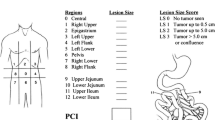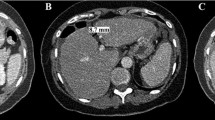Abstract
Background
This study evaluates the accuracy of computed tomography (CT) scoring of the peritoneal cancer index (PCI) and examines its association with surgical morbidity and outcomes in pseudomyxoma peritonei.
Methods
Forty-seven patients with pseudomyxoma peritonei had preoperative evaluation of CT scans and were treated with cytoreductive surgery and perioperative intraperitoneal chemotherapy. Their radiological PCI and intraoperative PCI were scored for determination of accuracy and for correlation with morbidity and outcomes.
Results
Accuracy in detecting peritoneal lesions regardless of size ranged from 51% to 85% in the abdominopelvic regions and 21% to 25% in the small intestinal regions. The sensitivity of CT detection of peritoneal implants ranged from 67% to 84% in the abdominopelvic regions and from 56% to 57% in the small intestinal regions. The specificity of CT detection of peritoneal lesions was 100% in all regions. Preoperative CT identification of larger peritoneal lesions in the right upper quadrant (P = 0.016), epigastrium (P = 0.003), left upper quadrant (P = 0.019), proximal jejunum (P = 0.022), distal jejunum (P = 0.022), and proximal ileum (P = 0.022) predicted development of severe complications. Similarly, larger peritoneal lesions in the right upper quadrant (P = 0.039), epigastrium (P = 0.024), right flank (P = 0.005), and right lower quadrant (P = 0.034) were negatively associated with disease-free survival, and the right upper quadrant (P = 0.037) was negatively associated with overall survival.
Conclusions
Preoperative CT scan depicting extensive upper abdominal and small bowel disease predicts the presence of severe complications after cytoreduction. Extensive disease in the right upper quadrant seems to be associated with a poorer survival outcome.

Similar content being viewed by others
References
Moran BJ, Cecil TD. The etiology, clinical presentation, and management of pseudomyxoma peritonei. Surg Oncol Clin North Am. 2003;12:585–603.
Sulkin TV, O’Neill H, Amin AI, Moran B. CT in pseudomyxoma peritonei: a review of 17 cases. Clin Radiol. 2002;57:608–13.
Sugarbaker PH. New standard of care for appendiceal epithelial neoplasms and pseudomyxoma peritonei syndrome? Lancet Oncol. 2006;7:69–76.
Elias D, Gilly F, Quenet F, et al. Pseudomyxoma peritonei: a French multicentric study of 301 patients treated with cytoreductive surgery and intraperitoneal chemotherapy. Eur J Surg Oncol. 2010;36:456–62.
Brendan M, Dario B, Tristan DY, Shigeki K, Marcello D. Consensus statement on the loco-regional treatment of appendiceal mucinous neoplasms with peritoneal dissemination (pseudomyxoma peritonei). J Surg Oncol. 2008;98:277–82.
Jacquet P, Sugarbaker PH. Current methodologies for clinical assessment of patients with peritoneal carcinomatosis. J Exp Clin Cancer Res. 1996;15:49–58.
Sugarbaker PH. Peritonectomy procedures. Ann Surg. 1995;221:29–42.
de Bree E, Koops W, Kröger R, et al. Peritoneal carcinomatosis from colorectal or appendiceal origin: correlation of preoperative CT with intraoperative findings and evaluation of interobserver agreement. J Surg Oncol. 2004;86:64–73.
Jacquet P, Jelinek JS, Steves MA, Sugarbaker PH. Evaluation of computed tomography in patients with peritoneal carcinomatosis. Cancer. 1993;72:1631–6.
Yan TD, Haveric N, Carmignani CP, Chang D, Sugarbaker PH. Abdominal computed tomography scans in the selection of patients with malignant peritoneal mesothelioma for comprehensive treatment with cytoreductive surgery and perioperative intraperitoneal chemotherapy. Cancer. 2005;103:839–49.
Passot G, Glehen O, Pellet O, et al. Pseudomyxoma peritonei: role of 18F-FDG PET in preoperative evaluation of pathological grade and potential for complete cytoreduction. Eur J Surg Oncol. 2010;36:315–23.
Chua TC, Saxena A, Schellekens JF, et al. Morbidity and mortality outcomes of cytoreductive surgery and perioperative intraperitoneal chemotherapy at a single tertiary institution: towards a new perspective of this treatment. Ann Surg. 2010;251:101–6.
Saxena A, Chua TC, Yan TD, Morris DL. Postoperative pancreatic fistula after cytoreductive surgery and perioperative intraperitoneal chemotherapy: incidence, risk factors, management, and clinical sequelae. Ann Surg Oncol. 2010;17:1302–10.
Kusamura S, Baratti D, Antonucci A, et al. Incidence of postoperative pancreatic fistula and hyperamylasemia after cytoreductive surgery and hyperthermic intraperitoneal chemotherapy. Ann Surg Oncol. 2007;14:3443–52.
Bijelic L, Sugarbaker PH. Cytoreduction of the small bowel surfaces. J Surg Oncol. 2008;97:176–9.
Kusamura S, Younan R, Baratti D, et al. Cytoreductive surgery followed by intraperitoneal hyperthermic perfusion. Cancer. 2006;106:1144–53.
Loungnarath R, Causeret S, Bossard N, et al. Cytoreductive surgery with intraperitoneal chemohyperthermia for the treatment of pseudomyxoma peritonei: a prospective study. Dis Colon Rectum. 2005;48:1372–9.
Smeenk RM, Verwaal VJ, Antonini N, Zoetmulder FA. Survival analysis of pseudomyxoma peritonei patients treated by cytoreductive surgery and hyperthermic intraperitoneal chemotherapy. Ann Surg. 2007;245:104–9.
Elias D, Honoré C, Ciuchendéa R, et al. Peritoneal pseudomyxoma: results of a systematic policy of complete cytoreductive surgery and hyperthermic intraperitoneal chemotherapy. Br J Surg. 2008;95:1164–71.
Chua TC, Yan TD, Smigielski ME, et al. Long-term survival in patients with pseudomyxoma peritonei treated with cytoreductive surgery and perioperative intraperitoneal chemotherapy:10 years of experience from a single institution. Ann Surg Oncol. 2009;16:1903–11.
Carmignani CP, Sugarbaker TA, Bromley CM, Sugarbaker PH. Intraperitoneal cancer dissemination: mechanisms of the patterns of spread. Cancer Metastasis Rev. 2003;22:465–72.
Author information
Authors and Affiliations
Corresponding author
Rights and permissions
About this article
Cite this article
Chua, T.C., Al-Zahrani, A., Saxena, A. et al. Determining the Association Between Preoperative Computed Tomography Findings and Postoperative Outcomes After Cytoreductive Surgery and Perioperative Intraperitoneal Chemotherapy for Pseudomyxoma Peritonei. Ann Surg Oncol 18, 1582–1589 (2011). https://doi.org/10.1245/s10434-010-1492-3
Received:
Published:
Issue Date:
DOI: https://doi.org/10.1245/s10434-010-1492-3




